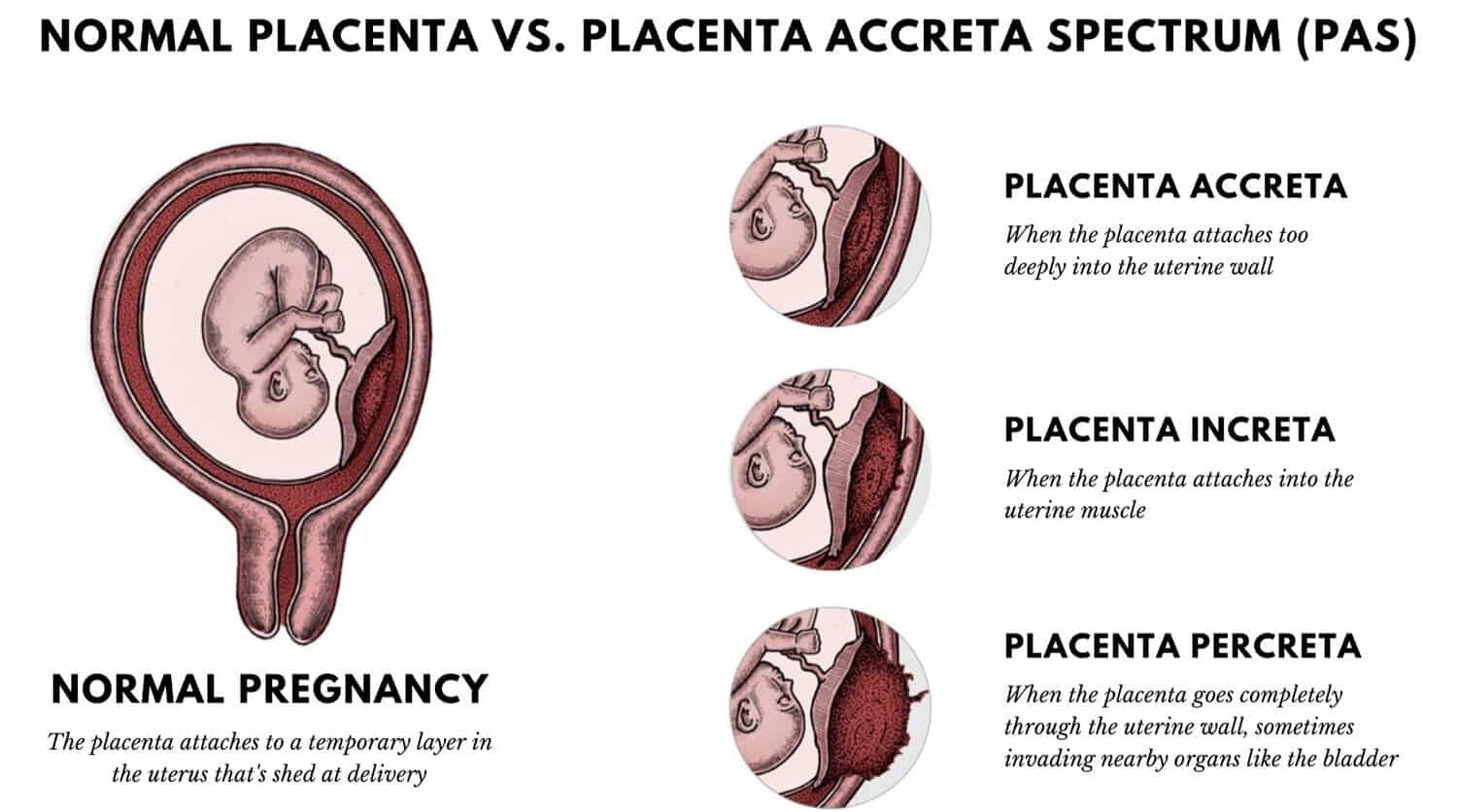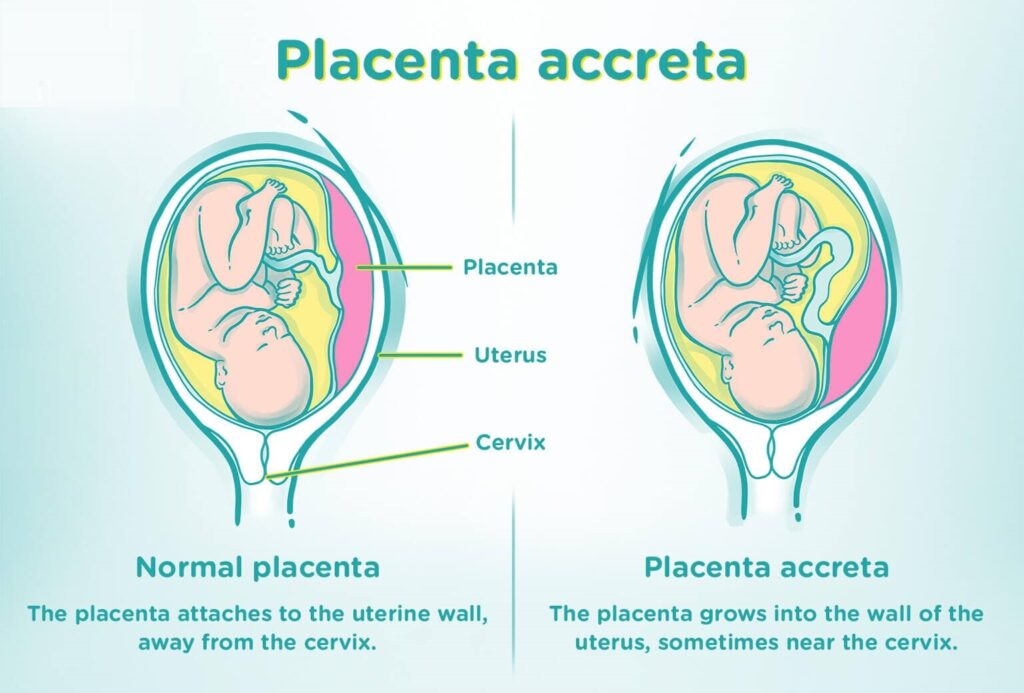WHAT IS PLACENTA ACCRETA?
Placenta accreta is a severe pregnancy condition that happens when the placenta grows too deeply inside the uterine wall.
Generally, the placenta separates from the uterine wall after childbirth. With placenta accreta, portion or all of the placenta remains attached. This could cause severe blood loss after delivery.
It is also possible that the placenta invades the muscles of the uterus (placenta increta) or develops across the uterine wall (placenta percreta).
Placenta accreta is referred to as a high-risk pregnancy complication. If the condition is diagnosed during pregnancy, you will likely require an early C-section delivery followed by the surgical removal of your uterus (hysterectomy).

PLACENTA ACCRETA SYMPTOMS
Placenta accreta usually causes no signs or symptoms during pregnancy — although vaginal bleeding during the third trimester may happen.
Occasionally, placenta accreta is discovered during a routine ultrasound.
PLACENTA ACCRETA CAUSES
Placenta accreta is thought to be associated with abnormalities in the lining of the uterus, typically because of scarring after a C-section or other uterine surgery. Sometimes, however, placenta accreta happens without a history of uterine surgery.

PLACENTA ACCRETA RISK FACTORS
Many factors could increase the risk of placenta accreta, including:
- Previous uterine surgery – The risk of placenta accrete rises with the number of C-sections or other uterine surgeries you have undergone.
- Placenta position – If the placenta partially or completely covers your cervix (placenta previa) or sits in the lower portion of your uterus, you are at increased risk of placenta accreta.
- Maternal age – Placenta accreta is more common in women older than 35 years.
- Previous childbirth – The risk of placenta accreta rises as your number of pregnancies increases.
PLACENTA ACCRETA COMPLICATIONS
Placenta accreta could cause:
- Heavy vaginal bleeding – Placenta accreta poses a major risk of serious vaginal bleeding (hemorrhage) after delivery. The bleeding could cause a life-threatening condition that prevents your blood from clotting normally (disseminated intravascular coagulopathy), as well as lung failure (adult respiratory distress syndrome) and kidney failure. A blood transfusion will probably be required.
- Premature birth – Placenta accreta may cause labor to start early. If placenta accreta causes bleeding during your pregnancy, you may need to deliver your baby early.

PLACENTA ACCRETA DIAGNOSIS
If you have risk factors for placenta accreta during pregnancy — like the placenta partially or completely covering the cervix (placenta previa) or a previous uterine surgery — your health care professional will carefully assess the implantation of your baby’s placenta.
Through an ultrasound or MRI, your health care professional could evaluate how deeply the placenta is implanted in your uterine wall.
PLACENTA ACCRETA TREATMENT
If your health care professional suspects placenta accreta, he or she will work with you to develop a method to carefully deliver your baby.
In the event of extensive placenta accreta, a C-section accompanied by the surgical removal of the uterus (hysterectomy) may be required. This procedure, also known as a cesarean hysterectomy, helps stop the potentially life-threatening blood loss that could happen if there is an attempt to detach the placenta.
If you have vaginal bleeding during the third trimester, your health care professional may recommend pelvic rest or hospitalization.
Before surgery
Your health care team will involve your obstetrician and gynecologist, subspecialists in pelvic surgery, an anesthesia team, and a pediatric team.
Your health care professional will discuss the risks and possible complications related to placenta accreta. He or she may also discuss the possibility of your:
- Having a blood transfusion during or after the delivery
- Need to be admitted to the intensive care unit after delivery if you have life-threatening bleeding

During surgery
During your C-section, your health care professional will deliver your baby through an initial incision in your abdomen and a second incision in your uterus. After the delivery, a member of your health care team will remove your uterus — with the placenta still attached — to stop severe bleeding.
After a hysterectomy, you no longer could become pregnant. If you had planned additional pregnancies in the future, discuss possible options with your health care professional.
Rarely, the uterus and placenta may be kept intact, allowing the placenta to dissolve over time. However, this approach could have severe complications, including:
- Severe vaginal bleeding
- Infection
- The requirement for a hysterectomy at a later date
In addition, limited research recommends that women who are able to avoid hysterectomy after having placenta accreta are at risk of complications, involving recurrent placenta accreta, with later pregnancies.
If you or anyone you know is suffering from placenta accreta, our expert providers at Specialty Care Clinics will take care of your health and help you recover.
Call (469) 545-9983 to book a telehealth appointment for an at-home check-up.
